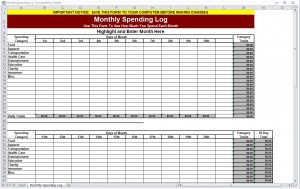
For most cash-strapped Americans, the notion of implementing a budget into their financial diet can be frightening.
It’s comparable to stepping on a scale. You know it’s necessary for achieving your projected goals, but nonetheless, it’s a jarring experience. The same goes for a weighty financial burden. Indebted consumers know it’s necessary, but nonetheless, it can be a candidly horrific self-analysis.
But just as continual weigh-ins for physical improvement are crucial, so are continual weigh-ins of your spending health for financial improvement. Cash-strapped consumers must assess their current portfolio from an overarching perspective long before they attempt to make any drastic changes, or implement specific improvement.
And with the Monthly Spending Log from MyExcelTemplates.com, users can house their monthly spending habits, as well as plan for future financial health, from a single, easy-to-use spreadsheet.

How to Improve Your Financial Health With a Monthly Spending Log
- Map your daily expenses by category. Although the template has outlined six major spending categories, the spreadsheet has room for users to add any customized information they please.
- Tally the total for your daily expenses. The bottom row for each individual, daily column will provide a space for compiling your daily spending total.
- Tally the total for specific categories. This will be your benchmark for pinpointing where the bulk of your funds are being allotted.
- After the 20-day mark, find the sum of your categories.
- After the duration of one month, find the sum of your total categories spent. This will comprise your monthly spending log. Use this figure to compare to a monthly income figure. If your spending totals inch too close – or go over – your total amassed income, begin searching for unique ways to scale back on specific, movable costs.
Tips for Executing an Effective Monthly Spending Log, and Avoid Wasting Money
- Try categorizing your expenses as essentials, or nonessentials. But contrary to popular belief, consider performing an assessment of your essentials within your Monthly Spending Log. Is it possible to sell a newer, more expensive car (with a higher monthly auto loan payment) for a cheaper, more cost-effective car? You might also try shopping around for cheaper insurance rates. Otherwise, consider pondering some ways to cut back on your nonessential expenses, like eating out or entertainment fees.
- Start up a substantial savings fund first. For most indebted consumers, this might seem a foolish notion. But emergencies can occur at anytime, and in any place. And they’re likely to wreak havoc on your finances and time without a proper financial cushion. Do your best to reach the $1,000 mark before putting more efforts towards chipping away at debt.
- Consider finding ways you’re ‘wasting’ your cash. According to 24/7 Wall Street Magazine, food away from home accounts for nearly 5.3 percent of a household’s annual income — a whopping $2,619 total.
Check out this offer while you wait!

